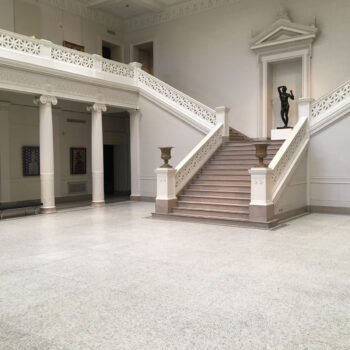The New Orleans Museum of Art (NOMA) was established in 1910 in the wake of an endowment received from sugar planter Issac Delgado. Known as the “Issac Delgado Museum of Art” for its first six decades, the museum’s historic core consists of a Greek Neoclassical structure completed in 1911 to a design by Samuel Marx. In 1971 three wings were added, extending from the east, west and north elevations of the original museum and providing for more exhibit space, improved amenities, and a dedicated auditorium. The 1971 additions were executed in a minimalist style, devoid of ornament and clad in white concrete aggregate panels. The formerly quadrangular museum became T-shaped in plan at this point and was renamed “The New Orleans Museum of Art.” In 1993, the most recent set of additions were completed, executed in a restrained postmodern style, and resulting in the creation of two rectangular courtyards about the east-west axis of the museum.
The museum interior contains two significant spaces. The skylit, covered central courtyard, just inside the main entry, is original to the 1911 structure and is executed in a highly detailed Greek Neoclassical style modified by decorative flourishes inspired by subtropical flora. A postmodern style atrium three stories high and dating to 1993 spans the museum’s east-west axis and provides dramatic, centralized access to every programmatic component of the building.
The New Orleans Museum of Art today boasts a collection of almost 40,000 objects, with notable strengths in French and American art, photography, glass, and African and Japanese works. The preferred venue in the region for important touring exhibitions, NOMA in its early years hosted a retrospective on Pablo Picasso (1940) organized by the Museum of Modern Art in New York City and welcomed, on the occasion of the 150th anniversary of the Louisiana Purchase, a survey of five centuries of French painting (1953), populated exclusively by works on loan from the Louvre. The museum’s 1971 expansion enabled the hosting of still more elaborate exhibitions, including those displaying treasures from the tomb of King Tut (1977) and artifacts addressing the life and times of Alexander the Great (1982), with the former exhibition welcoming nearly one million visitors in the course of its short run. The completion of the 1993 expansion permitted additional notable exhibitions, including one on the paintings of Claude Monet (1995) and, in honor of New Orleans’ 300th birthday, an exhibition (2018) displaying together for the first time since the 18th century many of the works collected by the city’s namesake, Philippe II, Duc d’Orleans. The most recent physical enlargement of NOMA’s footprint occurred with the debut in 2003 and expansion in 2019 of the outdoor Besthoff Sculpture Garden, installed around several lagoons adjacent to the museum.
Hired in late 2019 to provide contingent fee-based historic preservation consulting and tax credit monetization services for a $7.1 million rehabilitation of the museum’s Stern Auditorium, east courtyard, and café, Crescent Growth Capital’s in-house historic preservation specialist prepared a six-element Historic Preservation Certification Application over an eighteen-month period. The project reconfigured the non-historic auditorium to increase the space’s flexibility and technological capacity, with three of its four walls serving as the new location for Enrique Alferez’ “Spirit of Communication” (1967), salvaged from its original installation within the escalator lobby of the now-demolished Times-Picayune building in New Orleans. The non-historic east courtyard (1993) was enclosed, though extensive glazing preserves its light-filled character. Part 3 approval was received on May 17, 2021, with credit monetization accomplished by Crescent in September. Tax credit sale proceeds of approximately $1 million were subsequently delivered to NOMA.
1 Collins Diboll Cir, New Orleans, LA 70124










